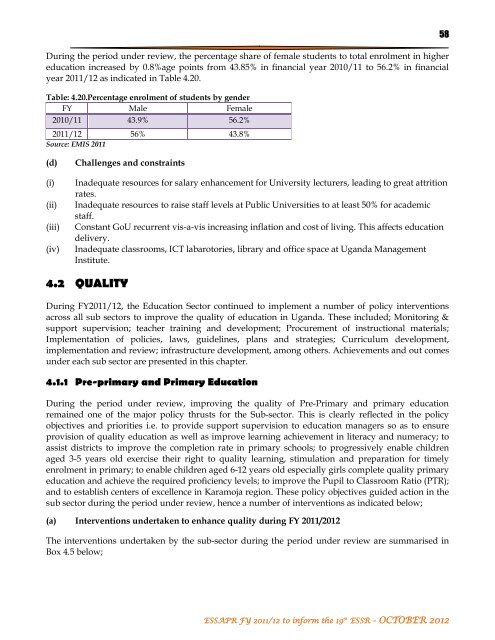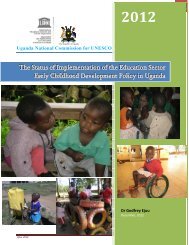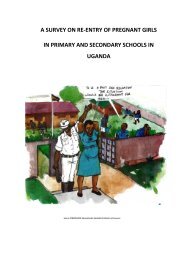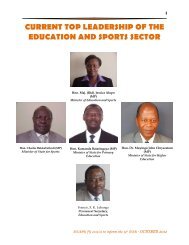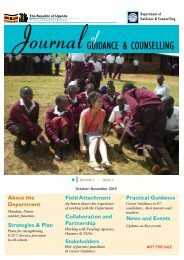Part I - Ministry Of Education and Sports
Part I - Ministry Of Education and Sports
Part I - Ministry Of Education and Sports
Create successful ePaper yourself
Turn your PDF publications into a flip-book with our unique Google optimized e-Paper software.
During the period under review, the percentage share of female students to total enrolment in higher<br />
education increased by 0.8%age points from 43.85% in financial year 2010/11 to 56.2% in financial<br />
year 2011/12 as indicated in Table 4.20.<br />
Table: 4.20.Percentage enrolment of students by gender<br />
FY Male Female<br />
2010/11 43.9% 56.2%<br />
2011/12 56% 43.8%<br />
Source: EMIS 2011<br />
(d) Challenges <strong>and</strong> constraints<br />
(i) Inadequate resources for salary enhancement for University lecturers, leading to great attrition<br />
rates.<br />
(ii) Inadequate resources to raise staff levels at Public Universities to at least 50% for academic<br />
staff.<br />
(iii) Constant GoU recurrent visavis increasing inflation <strong>and</strong> cost of living. This affects education<br />
delivery.<br />
(iv) Inadequate classrooms, ICT labarotories, library <strong>and</strong> office space at Ug<strong>and</strong>a Management<br />
Institute.<br />
4.2 QUALITY<br />
During FY2011/12, the <strong>Education</strong> Sector continued to implement a number of policy interventions<br />
across all sub sectors to improve the quality of education in Ug<strong>and</strong>a. These included; Monitoring &<br />
support supervision; teacher training <strong>and</strong> development; Procurement of instructional materials;<br />
Implementation of policies, laws, guidelines, plans <strong>and</strong> strategies; Curriculum development,<br />
implementation <strong>and</strong> review; infrastructure development, among others. Achievements <strong>and</strong> out comes<br />
under each sub sector are presented in this chapter.<br />
4.1.1 Pre‐primary <strong>and</strong> Primary <strong>Education</strong><br />
During the period under review, improving the quality of PrePrimary <strong>and</strong> primary education<br />
remained one of the major policy thrusts for the Subsector. This is clearly reflected in the policy<br />
objectives <strong>and</strong> priorities i.e. to provide support supervision to education managers so as to ensure<br />
provision of quality education as well as improve learning achievement in literacy <strong>and</strong> numeracy; to<br />
assist districts to improve the completion rate in primary schools; to progressively enable children<br />
aged 35 years old exercise their right to quality learning, stimulation <strong>and</strong> preparation for timely<br />
enrolment in primary; to enable children aged 612 years old especially girls complete quality primary<br />
education <strong>and</strong> achieve the required proficiency levels; to improve the Pupil to Classroom Ratio (PTR);<br />
<strong>and</strong> to establish centers of excellence in Karamoja region. These policy objectives guided action in the<br />
sub sector during the period under review, hence a number of interventions as indicated below;<br />
(a) Interventions undertaken to enhance quality during FY 2011/2012<br />
The interventions undertaken by the subsector during the period under review are summarised in<br />
Box 4.5 below;<br />
ESSAPR FY 2011/12 to inform the 19 th ESSR – OCTOBER 2012<br />
58


